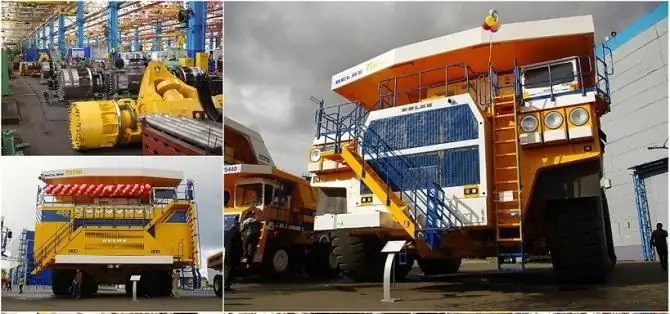2026 Author: Howard Calhoun | [email protected]. Last modified: 2025-06-01 07:12:56
The national economy of the Republic of Belarus, according to the state concept, is socially oriented, open, export-oriented, with significant scientific and innovative potential. In Soviet times, the region was called the “assembly shop” of the country, which Belarus still is today, maintaining close industrial ties with Russia, Ukraine, and other CIS countries.

Economic indicators
Since the economy of Belarus is an open export-oriented economy, it is highly affected by external factors of fluctuations in the world, and especially the Russian economy. The consequences of the global crisis, the stagnation of the industry of the Russian Federation due to sanctions and the collapse in the cost of hydrocarbons, the "subsidence" of the Ukrainian market hit hard in all areas of the country. There was a decline in GDP, the weakening of the Belarusian ruble, unemployment is growing, as a result, the standard of living of citizens has noticeably deteriorated.
To determine the level of economic development of the country and the resultseconomic activity, the main economic indicator is used - gross domestic product. In 2014, the national economy of Belarus achieved excellent GDP indicators - over $77 billion, or about $8,000 per person. For comparison: in 2010, GDP was just over $60 billion ($6,100 per person). However, these successes were achieved before the regional crisis that erupted at the end of 2014. Presumably, 2015 financial results will be less impressive.

GDP structure
As before, the leading contribution to the development of the Belarusian economy was made by the industrial sector. It accounts for a quarter of GDP. It is followed by trade and construction with a two-fold lag. Statistics for 2014 are as follows:
- industry - 24%;
- trade - 12.1%;
- taxes on products - 12.1%;
- construction - 10.4%;
- communications and transport - 7.9%;
- agriculture and forestry - 7.1%;
- other industries - 25.8%.
Leading trading partners: Russia (more than 40% of exports and 50% of imports), European countries (30% of exports and about 20% of imports), in particular, Ukraine, the Netherlands, Great Britain, Lithuania, Germany, Italy, Poland. Trade with China, Brazil, Venezuela, Kazakhstan, India, Turkey and other countries is developing dynamically.

Market economy
Belarus as a target socio-economic development modelconsiders a socially-oriented version of market relations. The economy of Belarus is based on:
- ensuring the personal rights and freedoms of citizens;
- priority desire of people to improve their well-being;
- building strong social protection;
- free enterprise;
- liberalization of various areas of economic activity;
- development of competition;
- promoting the international division of labor.
At the first stage of its development, direct state regulation is used in areas where, in fact, market self-regulation is ineffective. Innovative development with the attraction of external and internal investments is also of great importance.
The problem of unprofitable enterprises
In Belarus, the share of unprofitable organizations annually fluctuates between 20-25%, mostly in large and medium-sized cities, Grodno, Minsk and Smolevichi regions, mainly in trade and catering, partly in industry. To increase profitability, it is necessary to reduce the cost of production, reduce its material and energy intensity.

Economic structure
The economy of the Republic of Belarus is determined by the ratio of individual components of the economy and the relationship between them. Since 2011, a new classifier of types of economic activity has been applied in Belarus. In contrast to the sectoral (Soviet) division of the economy, now the whole variety of economic activities is divided into extractive,processing and providing services.
Mining includes a wide range of activities related to the production of agricultural products, hunting, forestry, fishing and fish farming, and the direct mining industry (potash s alts, building materials, hydrocarbons, etc.). The manufacturing industry is responsible for the processing of raw materials, production, distribution of electricity, water, gas. Financial activities, trade, education, public administration, transport, communications are listed in the "providing services" column.

Past and future
Traditionally, the economy of Belarus was agrarian-oriented, where logging, trade and crafts played an important role. Such a republic remained until the middle of the twentieth century. Explosive growth of industry began in the 1960s, due to the construction of new giant enterprises that became the locomotive of the entire sector, science-intensive industries, and the development of natural deposits of potash fertilizers and oil began.
At the same time, the agricultural sector not only retained a significant position, but was improved by the introduction of new technologies, the development of agricultural science, the availability of new agricultural machinery thanks to the products of local machine-building enterprises. The famous Belarus tractors are produced in Minsk, and the production of a full range of mechanized units has also been launched: from simple seeders to high-tech combines. The current economy of Belarus is agro-industrial.
Structural reforms are overdue in Belarus. The emphasis is on hightechnologies in agriculture and industrial production, the IT industry, the development of tourism, the use of the logistics potential of a transit country, the modernization of production based on local raw materials, etc. The government is implementing a number of large investment projects, the largest of which may be the construction of a giant industrial park of high technologies "Great Stone" together with Chinese partners. An important trend is efforts to diversify the economy and establish business, friendly interpersonal and political ties with countries and regions of all continents.
Recommended:
Sectors of the economy: types, classification, management and economics. The main branches of the national economy

Each country has its own economy. It is thanks to industry that the budget is replenished, the necessary goods, products, and raw materials are produced. The degree of development of the state largely depends on the efficiency of the national economy. The higher it is developed, the greater the economic potential of the country and, accordingly, the standard of living of its citizens
Modern production. The structure of modern production. Problems of modern production

Developed industry and a high level of the country's economy are key factors influencing the we alth and well-being of its population. Such a state has great economic opportunities and potential. A significant component of the economy of many countries is the production
Export is a key area of the modern economy

The volume of export operations is one of the indicators of the country's economic development. The strong position of the state in the international market testifies not only to production advantages, but also characterizes the competitiveness of products
Economy - what is it? Development of the country's economy

Science economics allows you to correctly analyze the processes of interaction between subjects of market relations, wisely spend and produce material resources, and also shows the ways of proper development and improvement of well-being
Appropriating economy - what is it? Appropriating economy: definition

Many historical facts testify to the origin of man from animals. Even 2 million years ago, he began to stand out among his own kind by upright walking, improving his hands and brain. Constant changes also took place in the field of food production. One of the ways to ensure existence was the appropriating economy. What it is and what it led to is described in this article

